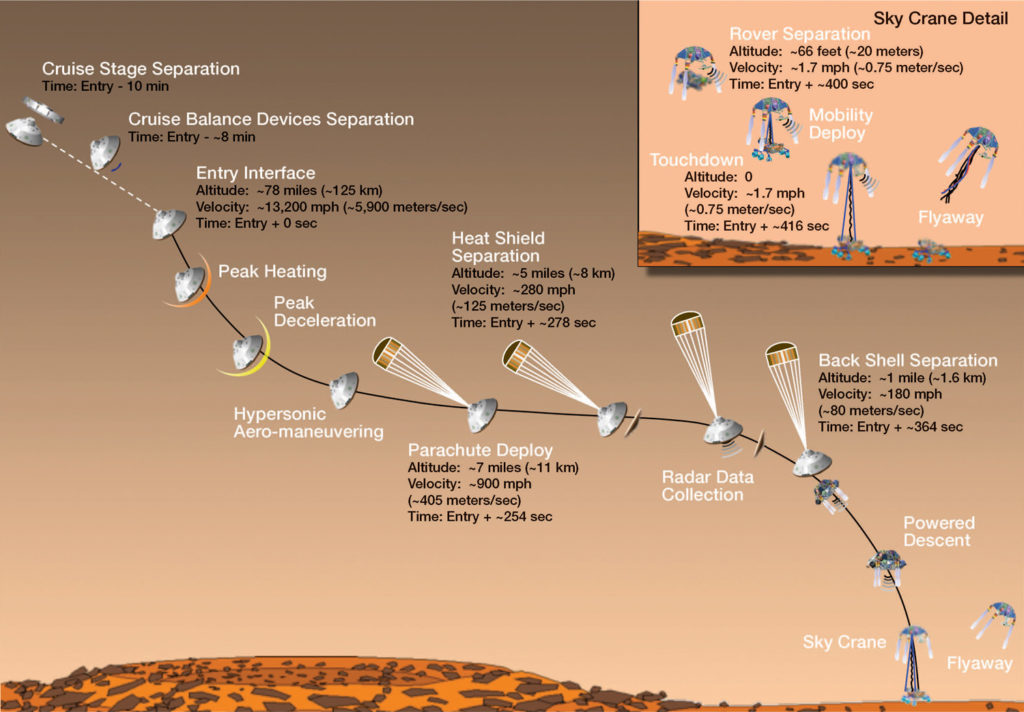After 7 months of journey through space to Mars, success for NASA’s Perseverance Rover will hinge on a few crucial moments known as 7 minutes of terror. The largest and most complicated piece of machinery after Curiosity which landed on the red planet on Aug. 6,2012.
Perseverance will begin its seven-minute fall through the wispy atmosphere on Feb. 18, 2021. On Earth, mission scientists will be unable to do anything but wait and hope for the signal that the six-wheeled remote laboratory is resting safely in the frail Martian sunlight.
As it looks mostly like the previous rovers sent to Mars, so how is Perseverance so different? Well it is a totally new rover with new and exciting capabilities and innovations not seen on other the rovers before.
7 minutes of terror
NASA’s Perseverance mission is different from any of those other rover mission however. Each of the past rovers landing sites offered different opportunities for exploration, with experiments to consider the possibility of past microbial life, examine Martian soil, rocks, and ground level atmosphere looking for signs of previous life. They were essentially doing robotic field geology.
The new Perseverance Rover will continue this science but will also concentrate on science that will help pave the way for human life on Mars someday.
The Perseverance Rover helps prepare for future human exploration of Mars by testing a technology for extracting oxygen from the Martian atmosphere, which is 96 percent carbon dioxide.
This new technology helps mission planners test ways of using Mars natural resources to support human explorers and improve designs for life support, transportation, and other important systems for living and working on Mars.
Back in 2012, Doug McCuistion, director of NASA’s Mars Exploration Program talking to National Geographic said “We go from 21,000 kilometres per hour to zero is seven minutes,”

NASA officials told the Jet Propulsion Laboratory in Pasadena, California, to ensure a 95% chance of landing success. Officials say after many simulations and tests, they found out only a 1.7% risk of failure.
But that holds only if the models have gone through every possible oddity of environment and machine. What’s worrisome are the unknown unknowns, says Steven Lee, the mission’s guidance, navigation and control-systems manager at the JPL. “Probably the overall biggest risk is our lack of imagination.”
It’s by no means assured that the rover will make it down in whole, some 60% of all Mars missions have failed.
“Landing on Mars is always risky,” Doug McCuistion said in the press conference held in Washington DC which was held for curiosity rover back in 2012.
“If one of them is out of place, it’s very likely that the rover, may hit the ground harder than planned,” he said.
Although the entire process is automated, it is a dangerous job. Which is carried out autonomously 505 Million Kilometers away.
There is some exciting addition to Perseverance, something that has never been done before. A sample collection and caching system has been added to the rover’s capabilities.
Perseverance will collect at least 20 pencil-sized cores, drilled from Martian rocks, seal them in tubes, and store them. NASA is confident that later missions will be able to retrieve those samples and return them to Earth for analysis.
And also, this is the first time ever a human made object would take flight on another planet i.e., Perseverance rover is carrying a Helicopter in the belly. It is one of the coolest pieces of equipment carried on the 2020 rover is the Mars Helicopter.
The laws of physics say that it is nearly impossible to fly a heavier than air vehicle on Mars with its thin atmosphere. Engineers however, going on the theory that if a helicopter is light enough and the blades spin fast enough, it should fly.
This is not it there are so many new feature and science equipment’s Perseverance is carrying on it. Perseverance is going to pave road for human exploration on Mars.
Additional Resources:
